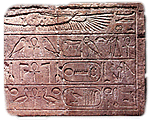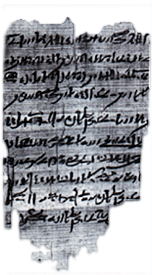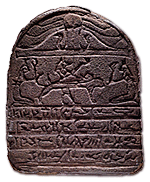|

|
|
Gallery
Tour
|
|
WRITING
Scribes, Hieroglyphs,
and Papyri
|
The University of Pennsylvania Museum
(UPM) has a comprehensive collection of material relating to writing and
literacy in ancient Egypt and Nubia.
As a complex historical society, ancient Egypt made extensive use of writing
and the written record has played a central role in the modern reconstruction
of Egyptian civilization.
Papyrus
The ancient Egyptians invented of type of paper called papyrus, which
was made from the river plant of the same name. Papyrus was a very strong
and durable paper-like material that was used in Egypt for over 3000
years. It is the precursor to modern paper, the name of which is derived
from the word "papyrus." Documents written on papyrus were
often sealed wtih a mud sealing embossed with a stamp from a scarab
seal, much in the same way that wax seals were later used.
Hieroglyphs
The ancient Egyptians used the distinctive script known today as hieroglyphs
(Greek for "sacred words") for almost 4,000 years. Hieroglyphs
were written on papyrus, carved in stone on tomb and temple walls, and
used to decorate many objects of cultic and daily
life use. Altogether there are over 700 different hieroglyphs, some
of which represent sounds or syllables; others that serve as determinatives
to clarify the meaning of a word. The hieroglyphic script originated
shortly before 3100 B.C., at the very onset of pharaonic civilization.
The last hieroglyphic inscription in Egypt was written in the 5th century
A.D., some 3500 years later. For almost 1500 years after that, the language
was unable to be read. In 1799, the Rosetta Stone was discovered in
Egypt by Napoleon's troops. The Rosetta Stone is a trilingual decree
(written in hieroglyphs, Greek, and Demotic) dating to the time of Ptolemy
V (205-180 B.C.). Its discovery proved to be a crucial link in unlocking
the mysteries of Egyptian hieroglyphs and in 1822, enabling Jean-François
Champollion to re-decipher the hieroglyphic signs, thereby allowing
the modern study of Egyptian language to begin.
Hieratic
While hieroglyphs are quite beautiful, they must have been very time
consuming for scribes to write. The Egyptians invented a cursive form
of hieroglyphs known as hieratic, which was used primarily for writing
with reed brushes, and later reed pens, on papyri and ostraca (fragments
of pottery or stone used as writing surfaces). This system of writing
was used alongside hieroglyphs for most of Egyptian history.
Demotic
An even more cursive form of script was invented during the 26th Dynasty
(664-525 B.C.). Known as Demotic, this form of writing was used at first
primarily for administrative documents, letters, and tax records. Eventually
it came to be used for literary and religious texts as well.
Coptic
Late in Egyptian history, the language known as Coptic, the final phase
of development of the ancient Egyptian language, came into being. Using
grammar that was very similar to its Demotic predecessor, Coptic used
the Greek alphabet plus a few signs derived from Demotic to form its
alphabet. Like the earlier Egyptian scripts, Coptic did not show breaks
between the words. Although it is no longer spoken, a dialect of Coptic
is still used in services of the Coptic church much in the same way
Latin was long used by the Roman Catholic Church.
Meroitic
The writing system for the Meroitic language of Nubia
appeared around the 2nd century B.C. The alphabet consisted of a combination
of hieroglyphic signs and cursive letters. Although the individual signs
can be pronounced, the Meroitic language is still not fully understood
and its texts are waiting to be deciphered and read.
|



